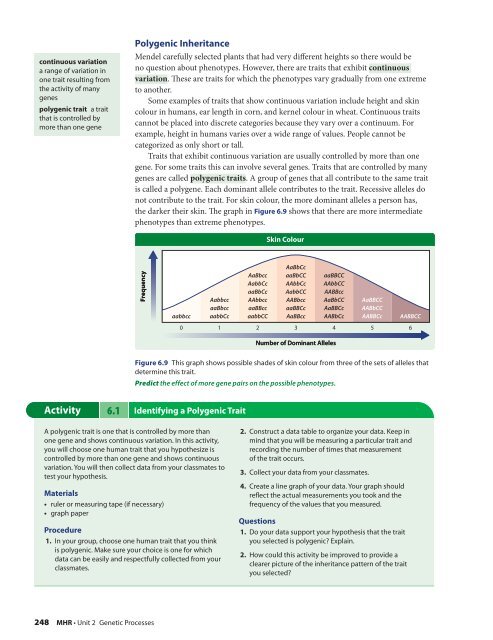REVIEW Chapter 6 - McGraw-Hill Ryerson
REVIEW Chapter 6 - McGraw-Hill Ryerson
REVIEW Chapter 6 - McGraw-Hill Ryerson
You also want an ePaper? Increase the reach of your titles
YUMPU automatically turns print PDFs into web optimized ePapers that Google loves.
continuous variation<br />
a range of variation in<br />
one trait resulting from<br />
the activity of many<br />
genes<br />
polygenic trait a trait<br />
that is controlled by<br />
more than one gene<br />
Polygenic Inheritance<br />
Mendel carefully selected plants that had very diff erent heights so there would be<br />
no question about phenotypes. However, there are traits that exhibit continuous<br />
variation. Th ese are traits for which the phenotypes vary gradually from one extreme<br />
to another.<br />
Some examples of traits that show continuous variation include height and skin<br />
colour in humans, ear length in corn, and kernel colour in wheat. Continuous traits<br />
cannot be placed into discrete categories because they vary over a continuum. For<br />
example, height in humans varies over a wide range of values. People cannot be<br />
categorized as only short or tall.<br />
Traits that exhibit continuous variation are usually controlled by more than one<br />
gene. For some traits this can involve several genes. Traits that are controlled by many<br />
genes are called polygenic traits. A group of genes that all contribute to the same trait<br />
is called a polygene. Each dominant allele contributes to the trait. Recessive alleles do<br />
not contribute to the trait. For skin colour, the more dominant alleles a person has,<br />
the darker their skin. Th e graph in Figure 6.9 shows that there are more intermediate<br />
phenotypes than extreme phenotypes.<br />
Frequency<br />
Skin Colour<br />
AaBbcc<br />
AaBbCc<br />
aaBbCC aaBBCC<br />
AabbCc AAbbCc AAbbCC<br />
aaBbCc AabbCC AABBcc<br />
Aabbcc AAbbcc AABbcc AaBbCC AaBBCC<br />
aaBbcc aaBBcc aaBBCc AaBBCc AABbCC<br />
aabbcc aabbCc aabbCC AaBBcc AABbCc AABBCc AABBCC<br />
0 1 2 3 4 5 6<br />
Number of Dominant Alleles<br />
Figure 6.9 This graph shows possible shades of skin colour from three of the sets of alleles that<br />
determine this trait.<br />
Predict the effect of more gene pairs on the possible phenotypes.<br />
Activity 6.1 Identifying a Polygenic Trait<br />
A polygenic trait is one that is controlled by more than<br />
one gene and shows continuous variation. In this activity,<br />
you will choose one human trait that you hypothesize is<br />
controlled by more than one gene and shows continuous<br />
variation. You will then collect data from your classmates to<br />
test your hypothesis.<br />
Materials<br />
• ruler or measuring tape (if necessary)<br />
• graph paper<br />
Procedure<br />
1. In your group, choose one human trait that you think<br />
is polygenic. Make sure your choice is one for which<br />
data can be easily and respectfully collected from your<br />
classmates.<br />
248 MHR • Unit 2 Genetic Processes<br />
2. Construct a data table to organize your data. Keep in<br />
mind that you will be measuring a particular trait and<br />
recording the number of times that measurement<br />
of the trait occurs.<br />
3. Collect your data from your classmates.<br />
4. Create a line graph of your data. Your graph should<br />
refl ect the actual measurements you took and the<br />
frequency of the values that you measured.<br />
Questions<br />
1. Do your data support your hypothesis that the trait<br />
you selected is polygenic? Explain.<br />
2. How could this activity be improved to provide a<br />
clearer picture of the inheritance pattern of the trait<br />
you selected?

















